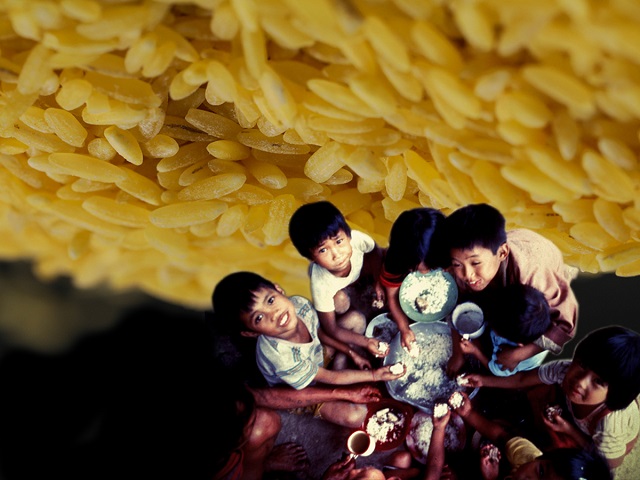|
Golden rice can provide significant and sustainable vitamin A in the diet of Filipinos The Philippines
Golden Rice, a type of rice that contains beta-carotene (a source of vitamin A), is now in the final stage of biosafety regulatory assessments. Once it gets the permit for commercial propagation anytime soon, the Department of Agriculture-Philippine Rice Research Institute (DA-PhilRice) will be preparing for its deployment initially on a pilot scale in areas where malnutrition, especially vitamin A deficiency, is high. Now, the question that people ask is: Is Golden Rice effective? To measure the potential nutritional impact of Golden Rice, let’s keep in mind these three Bs: beta-carotene, bioavailability, and bioconversion. The yellow grains of Golden Rice demonstrate the presence of beta-carotene, which is only available in the leaves and stems of ordinary rice plants. Adding genes from corn and a common soil microorganism enables the plant to produce beta-carotene in the rice grain, while maintaining all other characteristics of ordinary rice. Beta-carotene is an ideal source of vitamin A because the human body only converts as much as it needs. Rice has a simple and easily digestible food matrix, which allows for a high bioavailability and bioconversion of beta-carotene into vitamin A. Put simply, bioavailability is the total amount of the nutrients available in the rice grain — in this case, beta-carotene and other useful carotenoids — that can be digested, stored, and converted by the human body. Because beta-carotene has a natural tendency to degrade over time, the project team monitors beta-carotene content at various stages of the project, from harvest to storage to cooking: estimating from 100 grams of milled Golden Rice stored for two months in normal conditions, with 30% cooking losses in its calculations. Measurements at this stage show that there is sufficient beta-carotene in Golden Rice to meet the 30-50% estimated average requirement (EAR) of vitamin A for young children and mothers or lactating women. Once bioavailability of beta-carotene is estimated, the next factor to consider when calculating the potential vitamin A contribution of Golden Rice is the bioconversion rate, or the percentage of the absorbed carotenoids that is converted by the human body. This is measured in terms of retinol activity equivalents (RAE). Studies show that beta-carotene bioconversion varies significantly across different plant food sources. Staple crops and other foods with simple food matrices show a more efficient bioconversion rate than fruit or vegetable sources of beta-carotene. Golden Rice has a bioconversion rate of 3.8:1 — this means that the human body only needs 3.8 micrograms (µg) of beta-carotene from Golden Rice to convert into 1 µg RAE (vitamin A). In comparison, 21 µg of beta-carotene from cooked and pureed spinach and 15 µg from cooked and pureed carrot are needed by the body to convert into 1 µg RAE. The efficient bioconversion rate of Golden Rice is promising from a dietary perspective, given rising food costs and the persistent inadequacy of Filipino diets in terms of providing macro- and micronutrients. The 2018 FNRI Expanded National Nutrition (ENNS) Survey shows that rice continues to be a top source of energy across all Filipino households regardless of socio-economic status. While consumption of animal-based food increases with income, consumption of fruits and vegetables is consistently low across all households. While the 2018 ENNS shows a slight decline in Vitamin A deficiency (VAD) among young children, this continues to be a severe problem among children aged 12-23 months, as well as in children belonging to the poorest households. Data also shows the chronic inadequacy of Vitamin A intake in the Filipino diet and the lower prevalence of the recommended twice-yearly Vitamin A supplementation even among non-VAD children. Young children are disproportionately affected by VAD because proper nutrition during the first 1000 days of life directly affects physical and cognitive development. The prevalence of undernutrition, stunting, wasting, and anemia is higher among VAD children, which — if left untreated — will have lasting effects on their future productivity and quality of life. This underscores the need for a consistent supply of Vitamin A-rich food sources. A simulated analysis conducted shows that even substituting small amounts of ordinary rice with Golden Rice can produce a meaningful improvement in vitamin A intake among target populations. This demonstrates its potential as an affordable and sustainable means of providing needed micronutrients in the daily diet of Filipinos, supplementing other plant and animal food sources of vitamin A. The agriculture sector has a key role to play in improving the quality of Filipino diets, through nutrition sensitive practices that improve affordability and accessibility to a diverse range of foods, and by increasing the nutrient content of already accessible and affordable staple crops like rice. By working to bring Golden Rice to the tables of those who need it the most, DA-PhilRice is fulfilling its mandate to provide safe and nutritious rice, and paves the way for agriculture and nutrition sectors to work closely together to improve the health, well-being, and quality of life of all Filipinos. Golden rice is only one of the products under the Healthier Rice Project of DA-PhilRice. Other products in the pipeline include: high iron and high zinc rice. Also in the works is a 3-in-1 rice that contains essential micronutrients, such as vitamin A, zinc, and iron. To know more information or updates about Golden Rice, please like and follow Golden Rice Facebook ( https://www.facebook.com/GoldenRicePh ).
More news from: Philrice (Philippine Rice Research Institute) Website: http://www.philrice.gov.ph Published: May 14, 2021 |

